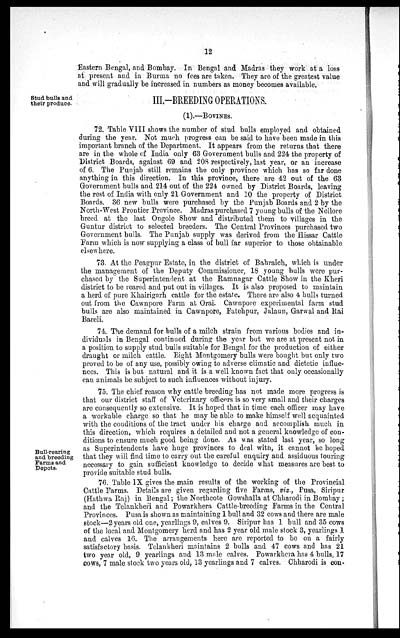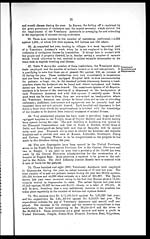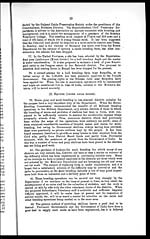Medicine - Veterinary > Civil Veterinary Departments > Annual administration report of the Civil Veterinary Department of India > 1905-1906 > Part A - Provincial administration
(21) Page 12
Download files
Individual page:
Thumbnail gallery: Grid view | List view

12
Eastern Bengal, and Bombay. In Bengal and Madras they work at a loss
at present and in Burma no fees are taken. They are of the greatest value
and will gradually be increased in numbers as money becomes available.
Stud bulls and
their produce.
III.—BREEDING OPERATIONS.
(1).—BOVINES.
72. Table VIII shows the number of stud bulls employed and obtained
during the year. Not much progress can be said to have been made in this
important branch of the Department. It appears from the returns that there
are in the whole of India only 63 Government bulls and 224 the property of
District Boards, against 69 and 208 respectively, last year, or an increase
of 6. The Punjab still remains the only province which has so far done
anything in this direction. In this province, there are 42 out of the 63
Government bulls and 214 out of the 224 owned by District Boards, leaving
the rest of India with only 21 Government and 10 the property of District
Boards. 36 new bulls were purchased by the Punjab Boards and 2 by the
North-West Frontier Province. Madras purchased 7 young bulls of the Nellore
breed at the last Ongole Show and distributed them to villages in the
Guntur district to selected breeders. The Central Provinces purchased two
Government bulls. The Punjab supply was derived from the Hissar Cattle
Farm which is now supplying a class of bull far superior to those obtainable
elsewhere.
73. At the Peagpur Estate, in the district of Bahraich, which is under
the management of the Deputy Commissioner, 18 young bulls were pur-
chased by the Superintendent at the Ramnagar Cattle Show in the Kheri
district to be reared and put out in villages. It is also proposed to maintain
a herd of pure Khairigarh cattle for the estate. There are also 4 bulls turned
out from the Cawnpore Farm at Orai. Cawnpore experimental farm stud
bulls are also maintained in Cawnpore, Fatehpur, Jalaun, Garwal and Rai
Bareli.
74. The demand for bulls of a milch strain from various bodies and in-
dividuals in Bengal continued during the year but we are at present not in
a position to supply stud bulls suitable for Bengal for the production of either
draught or milch cattle. Eight Montgomery bulls were bought but only two
proved to be of any use, possibly owing to adverse climatic and dietetic influe-
nces. This is but natural and it is a well known fact that only occasionally
can animals be subject to such influences without injury.
Bull-rearing
and breeding
Farms and
Depots.
75. The chief reason why cattle breeding has not made more progress is
that our district staff of Veterinary officers is so very small and their charges
are consequently so extensive. It is hoped that in time each officer may have
a workable charge so that he may be able to make himself well acquainted
with the conditions of the tract under his charge and accomplish much in
this direction, which requires a detailed and not a general knowledge of con-
ditions to ensure much good being done. As was stated last year, so long
as Superintendents have huge provinces to deal with, it cannot be hoped
that they will find time to carry out the careful enquiry and assiduous touring
necessary to gain sufficient knowledge to decide what measures are best to
provide suitable stud bulls.
76. Table IX gives the main results of the working of the Provincial
Cattle Farms. Details are given regarding five Farms, viz., Pusa, Siripur
(Hathwa Raj) in Bengal; the Northcote Gowshalla at Chharodi in Bombay ;
and the Telankheri and Powarkhera Cattle-breeding Farms in the Central
Provinces. Pusa is shown as maintaining 1 bull and 32 cows and there are male
stock—2years old one, yearlings 9, calves 9. Siripur has 1 bull and 35 cows
of the local and Montgomery herd and has 2 year old male stock 3, yearlings 1
and calves 16. The arrangements here are reported to be on a fairly
satisfactory basis. Telankheri maintains 2 bulls and 47 cows and has 21
two year old, 9 yearlings and 13 male calves. Powarkhera has 4 bulls, 17
cows, 7 male stock two years old, 13 yearlings and 7 calves. Chharodi is con-
Set display mode to: Large image | Zoom image | Transcription
Images and transcriptions on this page, including medium image downloads, may be used under the Creative Commons Attribution 4.0 International Licence unless otherwise stated. ![]()
| Permanent URL | https://digital.nls.uk/75509141 |
|---|




